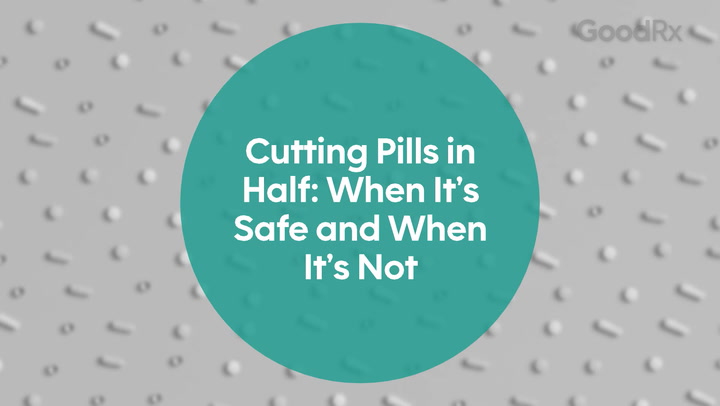
Sustained Release vs. Extended Release (vs. Other Modified-Release Dosage Forms)
Key takeaways:
Many modified-release dosage forms allow people to take fewer medication doses throughout the day. They can also help lessen certain side effects, such as stomach upset.
Modified-release dosage forms of medications may cost more and may be harder to swallow than their immediate-release forms.
Many modified-release dosage forms shouldn’t be cut, split, or altered in any way. This is to avoid the medication being released too quickly.
Table of contents

If you’ve taken an oral medication, such as a tablet or capsule, you may have noticed different letters — like SR, ER, and CR — following the medication’s name. You may be wondering what they mean or if they change how the medication works. These letters signify a modified-release dosage form.
There are many different medication dosage forms and each has unique characteristics to suit your individual needs. There are also benefits and drawbacks to consider. The same goes for modified-release dosage forms, which change how the medication is released in your body.
Below, we’ll review the different modified-release dosage forms, how they work in your body, and the best way to take them.
Search and compare options
What are the different types of modified-release dosage forms, and how are they different?
The most common oral dosage form is an immediate-release (IR) medication. While there are some exceptions, an IR medication usually dissolves shortly after entering the body and works very quickly for a short amount of time.
IR medications are absorbed and reach their peak level quickly. Medication levels will decline as your body removes it. This leads to varying medication levels in your body after taking a dose. For some medications, this could mean you need multiple doses in a single day to maintain a steady amount of medication in your body.
To make medications more convenient and better tolerated, many different dosage forms have been created to extend or delay their effects. These are known as modified-release dosage forms, and it’s important to know the difference between the most common ones — more on this below.
Extended release (ER or XR)
An extended-release medication is usually labeled with “ER” or “XR” at the end of its name. Medications that have ER forms are designed to make them last longer in your body. This allows the medication to be taken less often compared to the IR version, so you may only take 1 to 2 doses a day instead of 3 to 4.
Many different medications have ER forms, such as venlafaxine ER (Effexor XR). This ER antidepressant is taken once daily, compared to venlafaxine IR, which is taken 2 to 3 times daily. And some medications, such as Adderall XR, have both IR and ER components inside of it, allowing for faster onset and longer-lasting effects.
The term “extended release” is typically used as an umbrella term and can include medications that are both sustained- or controlled-release since they both allow for fewer daily doses.
Do not crush: If you have difficulty swallowing pills, you may be tempted to crush, split, or chew the tablet to make it easier to take. Here’s a list of medications that should always be swallowed whole.
Take on an empty stomach: While you should take some medications with a meal or snack, others should be taken without food. Learn more about medications you should take on an empty stomach and why.
What’s in your medication? Your prescription’s active ingredient is only one portion of your pill. It’s important to know what else is in your medication — especially if you have any allergies or dietary restrictions.
Sustained release (SR)
Sustained-release medications are usually labeled with “SR” at the end of their name. These forms prolong the medication’s release from a tablet or capsule so that you’ll get the medication’s benefits over a longer period of time. This means that you may need to take fewer doses throughout the day.
One example of this is bupropion SR (Wellbutrin SR), which is taken once daily, whereas the IR form is taken 2 to 3 times daily.
However, even though the medication is released over a longer period of time, it doesn’t mean the medication levels remain constant while it’s in your body. SR forms control the medication’s release, but not the amount in your body at a given time.
Controlled release (CR)
A controlled-release medication is usually labeled with “CR” at the end of its name. CR medications release the active ingredient(s) at a specific rate to keep constant medication levels in your body for a specific time period. This allows for more precise control of medication levels after taking it and fewer doses needed throughout the day.
Unlike SR forms, CR medications can precisely control the amount of medication in your body at a given time, not just its release.
The sleeping aid Ambien CR (zolpidem ER) is a good example of a CR medication. Ambien IR can wear off towards the end of the night, which might prevent some people from getting a proper night’s sleep. Ambien CR, on the other hand, releases the medication at a controlled rate to promote better sleep throughout the whole night.
Delayed release (DR)
Delayed-release (DR) medications are medications that are designed to release the active ingredient(s) later after taking it. This can help control where it’s released in the body, such as the small intestines. This is usually done to prevent the medication from being broken down too early or lessen potential side effects.
Some DR medications cause the active ingredient(s) to be released in the large intestine (the colon) in order to reach the area being treated. For example, sulfasalazine DR (Azulfidine EN-tabs) is a medication used to treat ulcerative colitis — an autoimmune condition that causes inflammation in the colon.
Enteric-coated (EC or “safety-coated”) medications are also considered to be a DR dosage form. They have a special film coating that stops them from being broken down in the stomach. This prevents the medication from being released until it reaches the small intestine, which may help lessen certain side effects, such as an upset stomach.
Aspirin is a common medication that is available as an EC form.
Why is it important to understand the difference?
It’s important to understand how a medication is released after taking it so you can predict how your body will react. For example, an IR medication usually works more quickly than a modified-release medication. Additionally, its effects may wear off faster because the medication is released all at once instead of over a longer period of time.
Modified-release medication forms may take longer to start working. This is because they’re typically absorbed more slowly. Or they don’t start breaking down until they reach a certain area in your body. And some modified-release medication forms (such as ER, SR, and CR) provide longer-lasting effects.
What are some disadvantages of modified-release dosage forms?
Modified-release dosage forms can be very useful in saving you time and allowing for fewer daily medication doses. But they can also have some disadvantages.
Modified-release dosage forms — particularly ER medications — can be much larger than IR forms. This can make them harder to swallow for some people. They also tend to cost more than their IR counterparts.
And in the event of a medication overdose, modified-release dosage forms may take more time to get out of your system because they’re designed to be in the body longer.
Finally, most modified-release dosage forms can’t be altered (e.g., cut, split, etc.). So it may be difficult to adjust your dose if a specific strength isn’t available.
Does pill-splitting, crushing, or chewing affect how the medication is released?
Most modified-release dosage forms shouldn’t be crushed, split, or chewed. When they’re cut, the active ingredient may be released much quicker and at a higher concentration than intended. This can be dangerous. In other words, you’ll receive a dose that’s normally released over a longer timeframe all at once.
Also, the medication might not be able to reach the proper location in your body if the tablet or capsule is crushed, split, or chewed. This means you may not get the proper effects of the medication.
However, some ER capsules, such as Adderall XR, may be opened up and mixed into foods like applesauce. Talk to your prescriber or pharmacist before altering any of your medications.
The bottom line
There are many different modified-release dosage forms available to help make taking medication more convenient. They are used for various reasons. Examples include taking fewer doses in a day, avoiding certain side effects, or better targeting the area being treated.
Modified-release dosage forms may be more convenient to take. But they are usually larger in size and can be more dangerous if not taken correctly. Talk to your prescriber to see if switching to a modified-release dosage form is right for you.
Why trust our experts?



References
Adepu, S., et al. (2021). Controlled drug delivery systems: Current status and future directions. Molecules.
Alembic Pharmaceuticals Limited. (2024). Venlafaxine hydrochloride capsule, extended release [package insert]. DailyMed.
Chandana, N., et al. (2013). Modified release dosage forms. Journal of Chemical and Pharmaceutical Sciences.
GlaxoSmithKline LLC. (2024). Wellbutrin SR- bupropion hydrochloride tablet, film coated [package insert]. DailyMed.
Kamble, R. S., et al. (2010). Enteric coated drug delivery system. Research Journal of Pharmacy and Technology.
Prajapati, S. T., et al. (2011). Formulation and evaluation of controlled-release tablet of zolpidem tartrate by melt granulation technique. International Scholarly Research Notices.
Sanofi-Aventis U.S. LLC. (2024). Ambien CR- zolpidem tartrate tablet, coated [package insert]. DailyMed.
Shargel, L., et al. (2012). Chapter 17. Modified-release drug products. Applied Biopharmaceutics and Pharmacokinetics. The McGraw-Hill Companies.
Takeda Pharmaceuticals America, Inc. (2023). Adderall XR- dextroamphetamine sulfate, dextroamphetamine saccharate, amphetamine sulfate and amphetamine aspartate capsule, extended release [package insert]. DailyMed.
Yaopharma Co., Ltd. (2024). Venlafaxine hydrochloride tablet [package insert]. DailyMed.
Was this page helpful?
Related Articles
Browse medications
View AllResearch prescriptions and over-the-counter medications from A to Z, compare drug prices, and start saving.

























